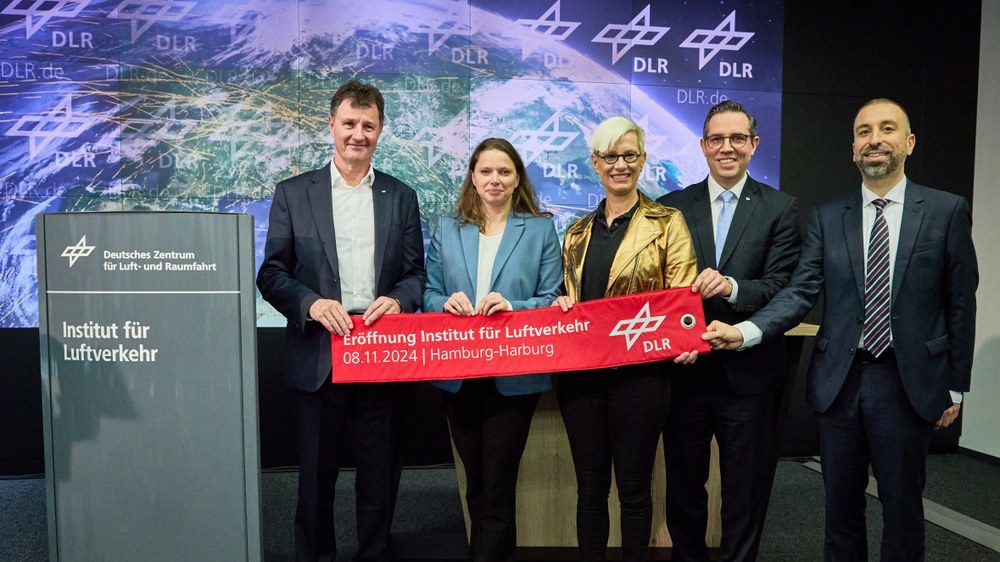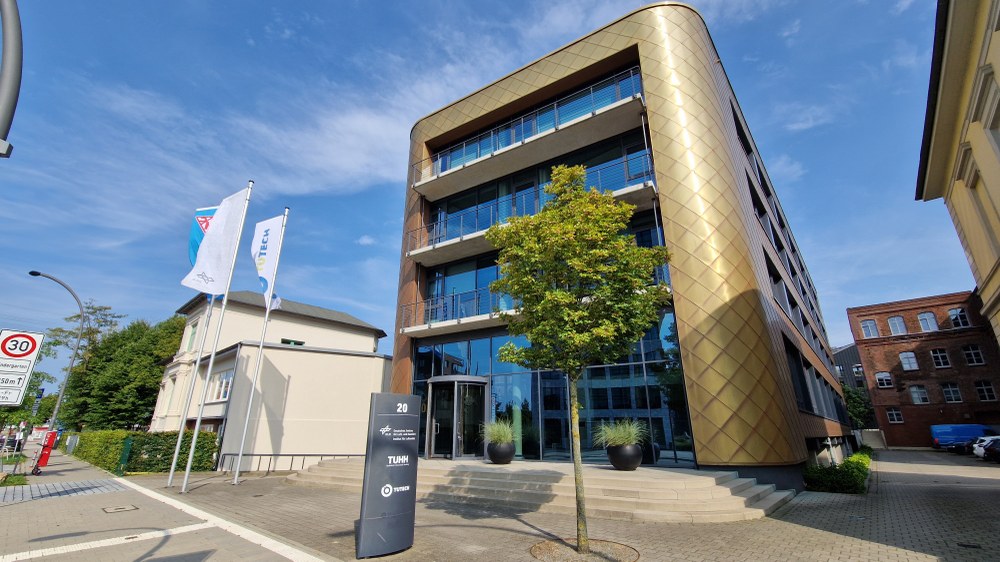DLR Institute of Air Transport officially opened in Hamburg



- The new institute consolidates research expertise on air transport and positions itself as a key point of contact for industry, society and policymakers.
- It is a merger of DLR's Air Transportation Systems Lab the Institute of Air Transport and Airport Research.
- The research carried out here is split into four departments: Air Transport Development, Air Transport Economics, Air Transport Management and Flight Operations Concepts.
- Focus: Aviation, transport
Making modern air transport more climate-compatible, user-friendly and efficient – this is the goal of the German Aerospace Center's (Deutsches Zentrum für Luft- und Raumfahrt; DLR) new Institute of Air Transport. Researchers are investigating how the air transport system is developing in an increasingly complex world, the impacts of transport policy and operational measures and the consequences of technological innovations. The DLR Institute of Air Transport was officially opened in Hamburg on 8 November 2024.
"Rising costs and increasing international competition pose a major challenge for Germany as a hub for aviation. The process of transformation towards climate-compatible aviation is also resulting in serious changes and upheavals for airlines and airports," explains Anke Kaysser-Pyzalla, Chair of the DLR Executive Board. "With the new DLR Institute of Air Transport, we are addressing the pressing ecological, economic, operational and regulatory issues of air transport. This makes us a key point of contact for public stakeholders and policymakers, the aviation industry and society, providing constructive and innovative support for upcoming changes."
"The opening of the DLR Institute of Air Transport is a further milestone for Hamburg as a leading aviation hub," said Melanie Leonhard, Minister of Economics and Innovation of the Free and Hanseatic City of Hamburg. "The institute pools expertise and provides important impetus for sustainable and competitive aviation. The close cooperation between business, research and policy in Hamburg thus enables valuable innovations. Hamburg is thereby making its contribution to technologies that will further advance aviation internationally".
Monitoring the aviation landscape
DLR's new Institute of Air Transport was created from a merger of the Institute of Air Transportation Systems and the Institute of Air Transport and Airport Research. In addition to its headquarters in Hamburg-Harburg, the Institute will retain its office in Cologne. Approximately 65 employees work at the institute, with four departments focusing on flight operation concepts, air transport management, air transport development and air transport economics. The institute is also responsible for producing DLR's own air traffic forecast. Based on this, DLR regularly publishes the Low Cost Monitor, the Global Aviation Monitor and the DLR Tourism Report, which provide a comprehensive overview of current air transport trends and developments.
Creating a digital airline twin
Innovative flight procedures for efficient and sustainable air transport are also a focus of the institute's research, as is the evaluation of environmental policy and regulatory measures. Another important research area includes the economic aspects of airlines and airports, as well as other players in the air transport system. The first 'digital airline twin' will be created in Hamburg under the direction of the DLR Institute of Air Transport. This will be used to model, analyse and visualise practical challenges for the operation of an airline on an unprecedented scale. In the area of airports, the institute has recently made a significant contribution to the development of a roadmap for the use of hydrogen at Hamburg Airport.
Diverse consulting services
The Institute of Air Transport contributes its wide-ranging expertise in economics, engineering, mathematics, computer science, physics, meteorology and geography to committees at national, European and global levels. The institute was and is also significantly involved in developing methods for assessing aviation technologies in terms of their carbon dioxide (CO2) and non-CO2 emissions.
The DLR Institute of Air Transport benefits from numerous interfaces with other DLR institutes in the fields of aviation, transport and energy. The two locations in Hamburg and Cologne also offer synergies with other important players in the aviation sector due to their proximity to airports, the aviation industry, policymakers and administration as well as research institutions.
Three questions for Florian Linke, acting director of the DLR Institute of Air Transport
Air transport is constantly evolving. The interplay between airports, flight routes and the aircraft in use forms a complex global network. What tools and analyses does the new institute have at its disposal to assess the state of air transport? What major trends are currently emerging?

"Our institute has extensive access to data that allows us to conduct comprehensive analyses of air transport. We utilise a wide range of data sources, including historical and future flight schedules, passenger demand between cities, airline fleet composition, ticket prices, location costs and detailed flight performance, emissions and atmospheric data. This data set provides us with a complete picture of the current and past state of air transport, enabling us to identify trends. This is complemented by our descriptive and predictive models, which we use to track changes in passenger numbers and flight frequencies or to calculate the extent to which aviation contributes to global greenhouse gas emissions. Our regular reports, such as the Low Cost Monitor, the Global Aviation Monitor and the DLR Tourism Report, provide the industry with up-to-date analyses and insights.
Global aviation is gradually recovering to pre-COVID levels, but Germany is lagging behind, particularly when it comes to decentralised connections. There are many reasons for this, but it is likely due to high location costs and weak economic growth. This reduces the attractiveness for low-cost airlines and presents challenges for the development of regional airports. In the medium term, we expect further growth in air transport; however, capacity limits at many airports increasingly require the use of larger aircraft. Additionally, current geopolitical developments are leading to changes in air traffic flows and, in some cases, longer flight routes and increased fuel consumption. At the same time, there are numerous initiatives worldwide to make aviation more climate-compatible, in particular through sustainable fuels derived from biomass and renewable energy sources. New methods for avoiding condensation trails (contrails) are also promising."
Digital twins are now playing an important role in many fields. What could a digital replica of an airline look like?
"With our digital airline twin, we combine various models to map and optimise airline operations at both the fleet and flight operations level. This allows us to replicate airlines' strategic and tactical planning and decision-making processes and to visualise and evaluate the impact of possible decisions. By examining key planning processes, such as network planning, scheduling and rotation planning, in an integrated manner, we can better understand their interdependencies and make more robust decisions. We are all familiar with delayed flights. Such delays can snowball throughout the day, causing the crew to reach their maximum permissible working hours. In these cases, airlines must make informed decisions, considering both fleet and flight operations, to achieve an optimal economic outcome. Developing the digital airline twin ultimately supports more effective collaboration with the aviation industry in developing innovative solutions."
Climate-compatible aviation requires innovative technologies to transform flying, and on the policy side, the regulation of climate-relevant CO2 and non-CO2 emissions also plays a role. How does the institute contribute its expertise in these areas?
"The climate impact of aviation is not only caused by its CO2 emissions, but also by non-CO2 effects, such as nitrogen oxide emissions and contrails. Since these non-CO2 effects significantly depend on where emissions are released by an aircraft, we at the DLR Institute of Air Transport play a crucial role. We provide vital data for climate models by determining the quantity and location of emissions, considering the type of aircraft and flight routes. With this operational know-how, we contributed to developing a methodology for estimating CO2 equivalents, which is used by the Climate-Neutral Aviation Working Group (AKKL) initiated by the German Federal Ministry of Education and Research (BMBF) and the German Federal Ministry for Digital and Transport (BMDV). This method is used to evaluate technologies aimed at reducing the climate impact of aviation. In addition to this national committee, we actively participate in several European and international working groups.
One project we are currently working on with airlines, air traffic control and other DLR institutes is D-KULT. Here, we are investigating the conditions under which it is feasible to plan climate-optimised flights that specifically avoid contrail formation. To incentivise operators to conduct such flights, an extension of the EU Emissions Trading System is being discussed to include non-CO2 effects. In recent years, we have successfully carried out research projects for the German Environment Agency, demonstrating the feasibility of this extension. The next step is to shape the procedure in dialogue with airlines to ensure that uncertainties do not lead to counterproductive incentives."
